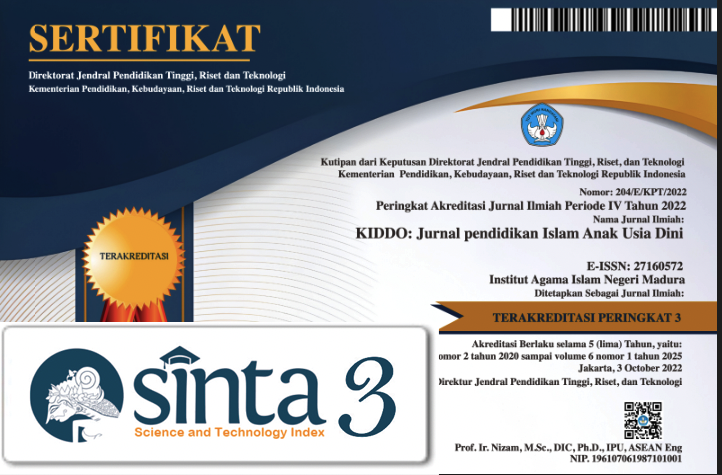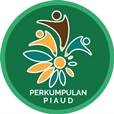Implementation of Differentiated Learning to Increase Children's Creativity
 Abstract views: 1539
,
Abstract views: 1539
,
 PDF downloads: 1526
PDF downloads: 1526
Abstract
This study aims to describe differentiation learning in increasing children's creativity. The research approach used is a qualitative research approach. Data was collected using observation sheets, interviews and documentation. The documentation used is anecdotal notes, child development reports and works. The data that has been collected is analyzed using the Miles and Huberman data analysis technique which contains four stages including: data collection, data reduction, data display, and drawing conclusions. To see the validity of the data in this study, the validity of the data was tested using technical triangulation. The results of the study show that differentiated learning develops children's creative abilities through providing opportunities for children to learn according to their individual characteristics and providing various choices of media that can be used by children according to their interests. So that children are free to be creative through facilitated media
Downloads
References
Bråten, I. (1991). Vygotsky as Precursor to Metacognitive Theory: II. Vygotsky as Metacognitivist. Scandinavian Journal of Educational Research, 35(4), 305–320. https://doi.org/10.1080/0031383910350406
Erbil, D. G. (2020). A Review of Flipped Classroom and Cooperative Learning Method Within the Context of Vygotsky Theory. Frontiers in Psychology, 11(June), 1–9. https://doi.org/10.3389/fpsyg.2020.01157
Hairiyah, S., & Mukhlis. (2019). Pengembangan Kreativitas Anak Usia Dini Melalui Permainan Edukatif. Jurnal Kariman, 7(2), 265–282. https://doi.org/10.52185/kariman.v7i2.118
Hasnawati, N. (2022). Peningkatan Kreativitas Siswa Melalui Strategi Pembelajaran Berdiferensiasi pada Pembelajaran PAI di SMAN 4 Wajo. Educandum, 8(2), 229–241.
Herwina, W. (2021). Optimalisasi Kebutuhan Murid Dan Hasil Belajar Dengan Pembelajaran Berdiferensiasi. Perspektif Ilmu Pendidikan, 35(2), 175–182. https://doi.org/10.21009/pip.352.10
Ilmu, J., & Nasional, P. (2023). Jurnal Ilmu Pendidikan Nasional Studi Literatur Menumbuhkan Motivasi Belajar Siswa Melalui Strategi Pembelajaran Berdiferensiasi Dalam Konteks Pedagogi Jurnal Ilmu Pendidikan Nasional. 1(April), 1–7.
Kamil, N., Dewi, U. K., Shope, Y. A., Afkarina, M., & Hayati, K. N. (2023). Pembelajaran Berdiferensiasi pada Satuan PAUD di Negara Indonesia dan Inggris Pendahuluan Metode. 13(1), 588–599.
Lasmawan, I. W., & Budiarta, I. W. (2020). Vygotsky’s Zone Of Proximal Development and The Students’ Progress in Learning (A Heutagogcal Bibliographical Review). JPI (Jurnal Pendidikan Indonesia), 9(4), 545. https://doi.org/10.23887/jpi-undiksha.v9i4.29915
Lestariningrum, A. (2022). Konsep Pembelajaran Terdefirensiasi Dalam Kurikulum Merdeka Jenjang PAUD. Semdikjar 5, 5, 179–184.
Lindblom, J., & Ziemke, T. (2002). Social Situatedness: Vygotsky and Beyond. Knowledge Creation Diffusion Utilization, 94, 71–78. http://cogprints.org/2517/
Mathematics, A. (2016). 済無No Title No Title No Title. 1–23.
Moll, L. (1991). The material and the social in Vygotsky’s theory of cognitive development. Society for Research in Child Development, 18–21.
Ngaisah, N. C., & Aulia, R. (2023). ANAK USIA DINI anak untuk memasuki jenjang Sekolah Dasar atau Madrasah Ibtidaiyah . 1 secara instan . 3 Anak membutuhkan kebebasan dan kemerdekaan dalam untuk memenuhi kebutuhan berdiferensiasi anak , pendidik kurilulum menggunakan sistem pembelajaran. Jurnal Pendidikan Anak Bunayya, 9, 1–25.
Safarati, N. (2023). Literature Review: Pembelajaran Berdiferensiasi Di Sekolah Menengah. Literature Review, 6(November), 33–37.
Silalahi, R. M. (2019). Understanding Vygotsky’S Zone of Proximal Development for Learning. Polyglot: Jurnal Ilmiah, 15(2), 169. https://doi.org/10.19166/pji.v15i2.1544
Sit, M., Khadijah, Nasution, F., Wahyuni, S., Rohani, Nurhayani, Sitorus, A. S., & Armayanti, R. (2016). Pengembangan Kreativitas Anak Usia Dini Pengembangan Teori dan Praktik. In Perdana Publishing.
Tomlinson, M. (2005). Blackwell Handbook of Childhood Cognitive Development by Usha Goswami (Editor). Journal of Child & Adolescent Mental Health, 17(2), 81–82. https://doi.org/10.2989/17280580509486605
Topçiu, M., & Myftiu, J. (2015). Vygotsky Theory on Social Interaction and its Influence on the Development of Pre-School Children. European Journal of Social Sciences Education and Research, 4(1), 172. https://doi.org/10.26417/ejser.v4i1.p172-179
Yu, Y. H., Hu, Y. N., & Zhang, J. S. (2013). A research on reading model of interactive children picture book application based on the theory of “zone of proximal development.” Applied Mechanics and Materials, 411–414(4), 2952–2956. https://doi.org/10.4028/www.scientific.net/AMM.411-414.2952
Copyright (c) 2023 Naili Sa'ida

This work is licensed under a Creative Commons Attribution 4.0 International License.
-
The journal operates an Open Access policy under a Creative Commons 4.0 International license. The terms of the license are:
Share— copy and redistribute the material in any medium or format
Adapt— remix, transform, and build upon the material for any purpose, even commercially.
1. Authors retain copyright and grant the journal right of first publication with the work simultaneously licensed under a Creative Commons License.that allows others to share the work with an acknowledgement of the work’s authorship and initial publication in this journal
2. Authors are permitted and encouraged to post their work online (e.g., in institutional repositories or on their website) prior to and during the submission process, as it can lead to productive exchanges, as well as earlier and greater citation of published work (See The Effect of Open Access).
Jurnal Kiddo is licensed under a Creative Commons
n Access).














